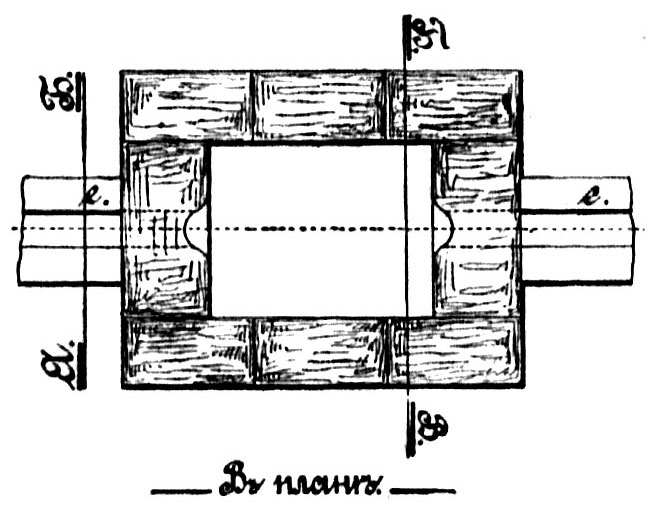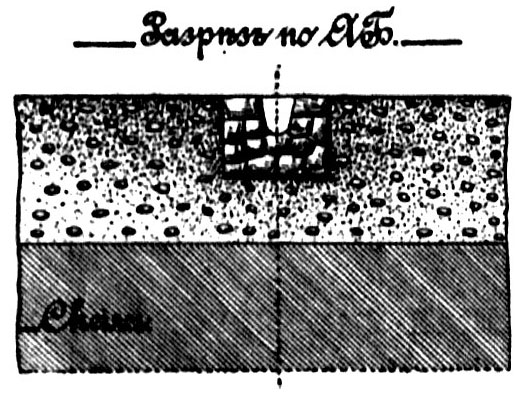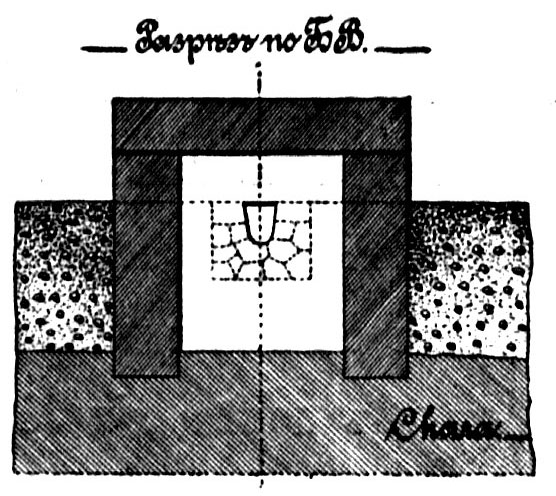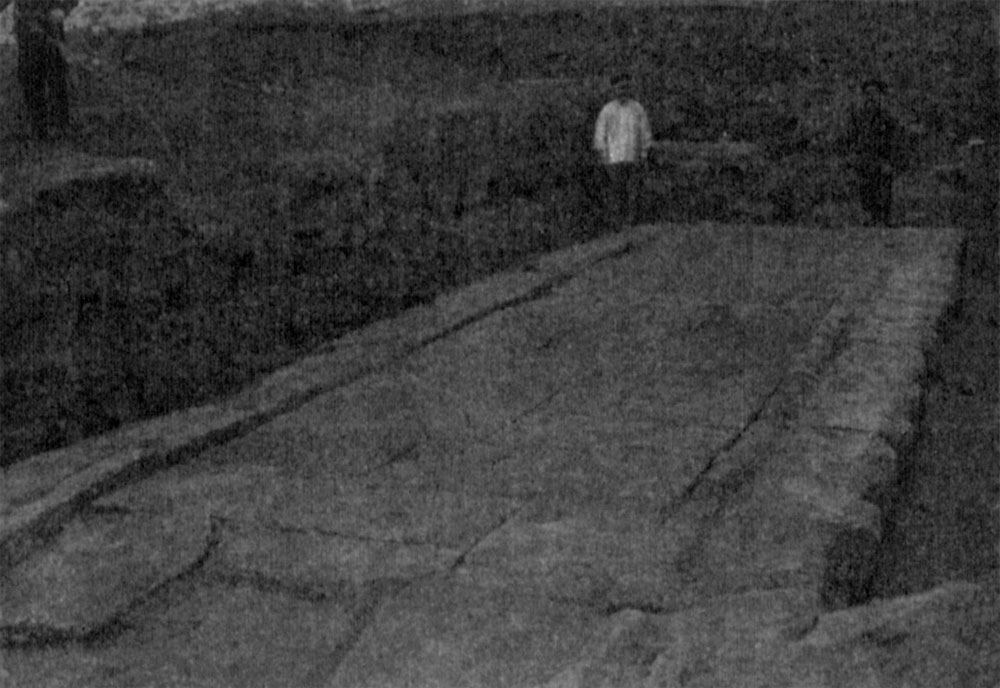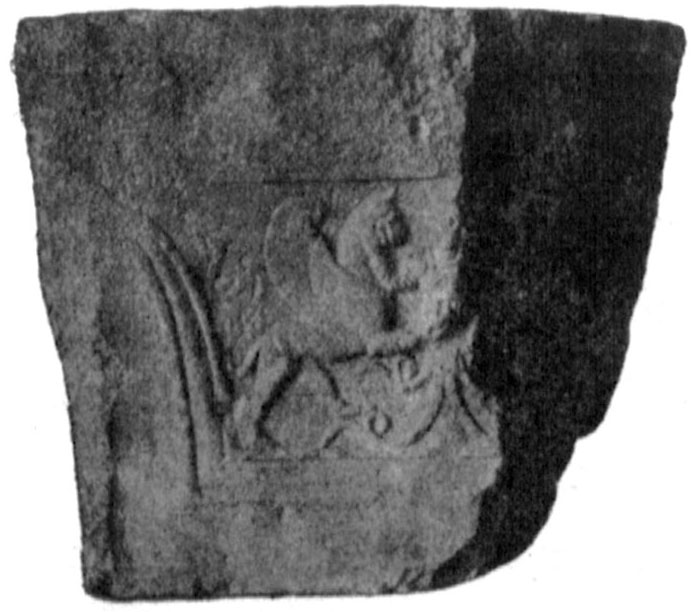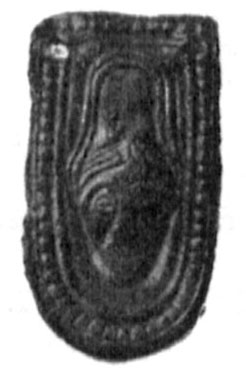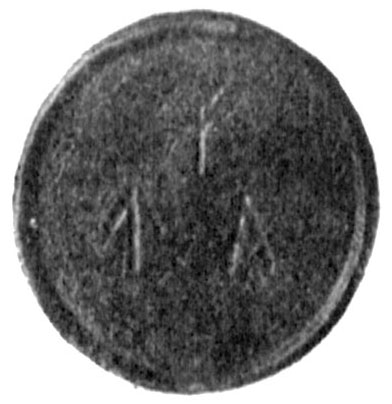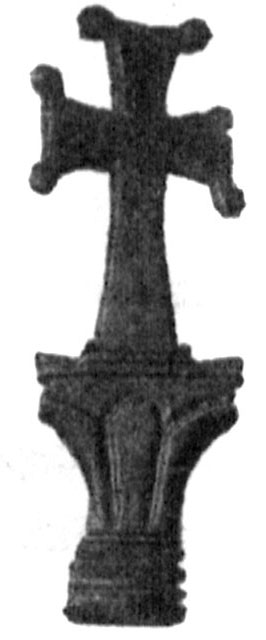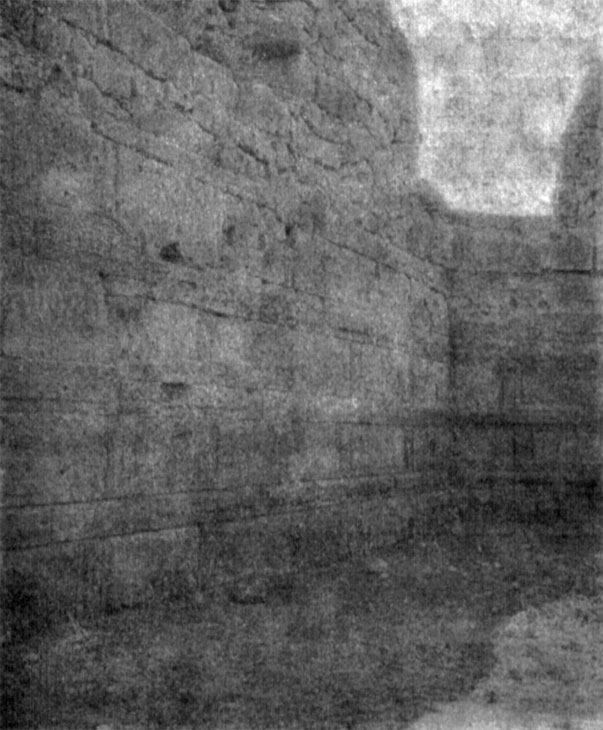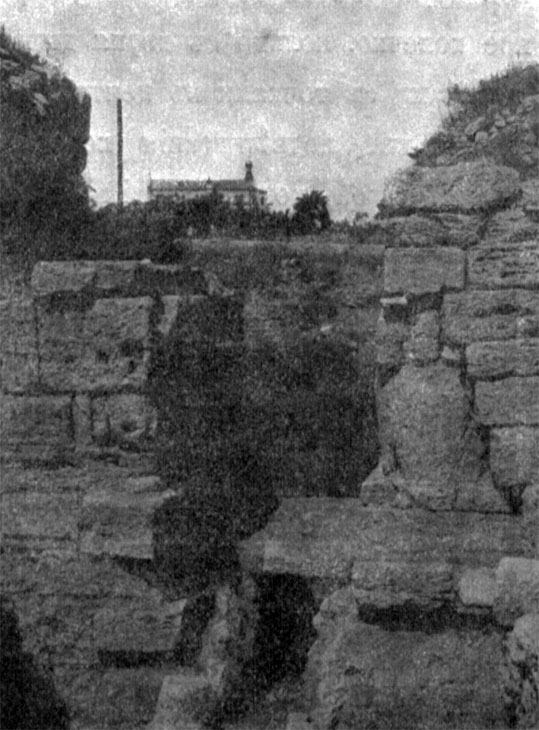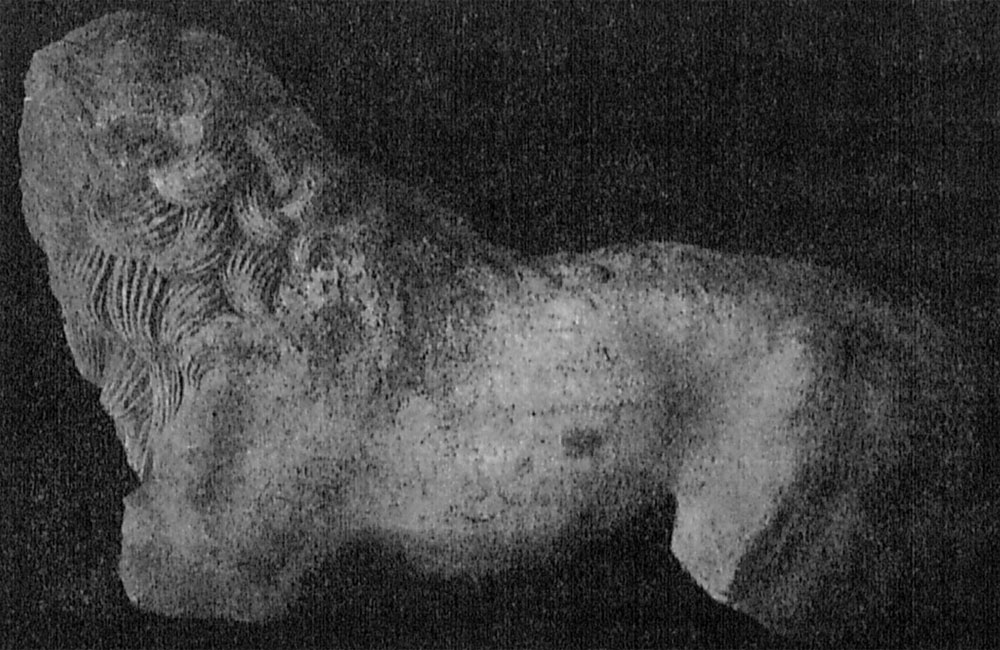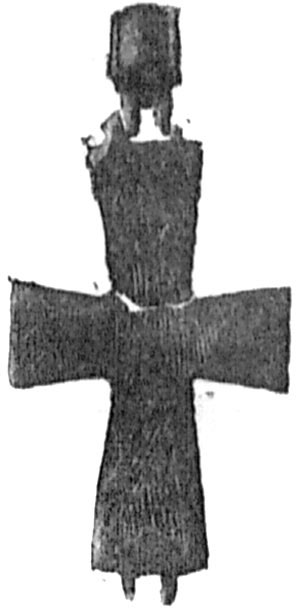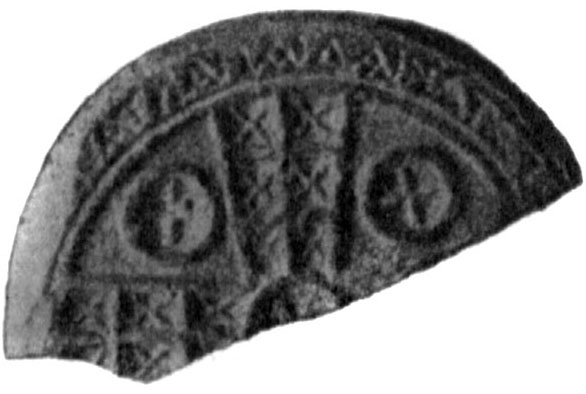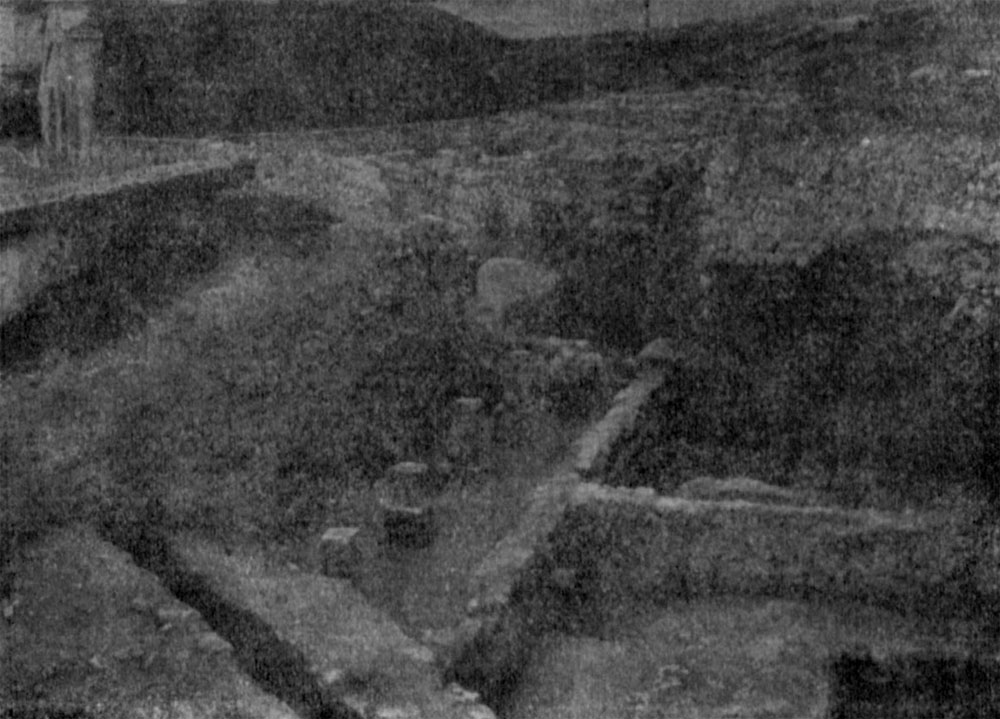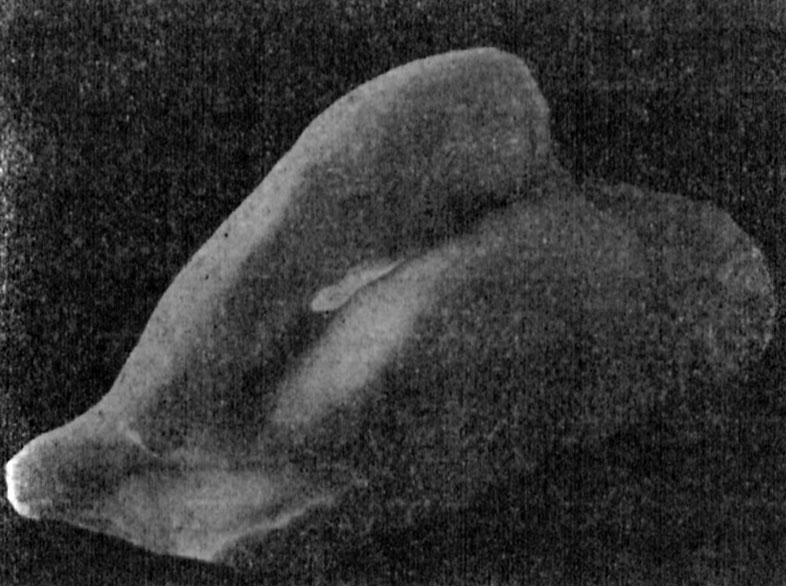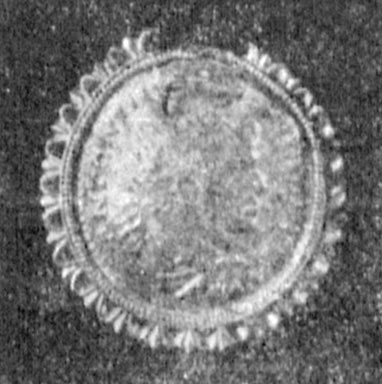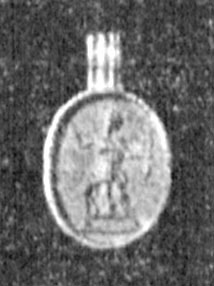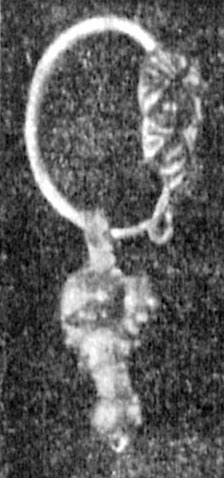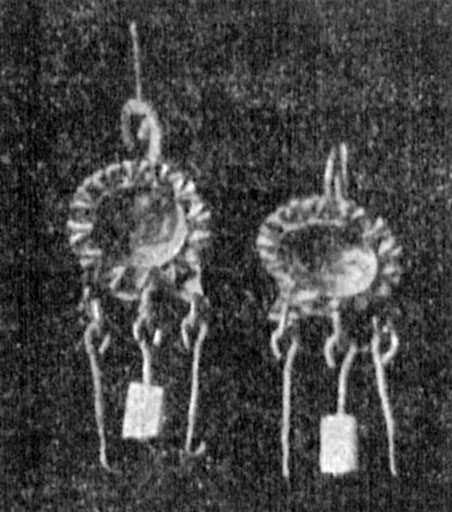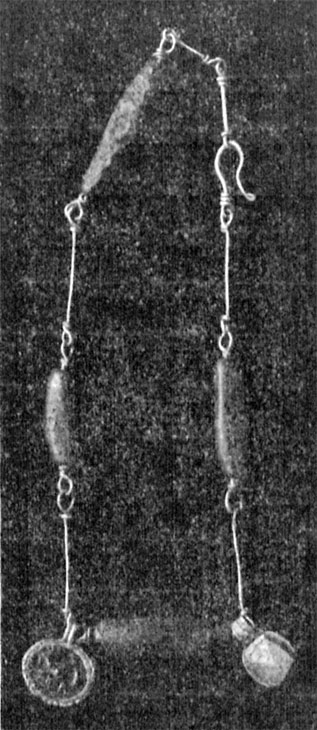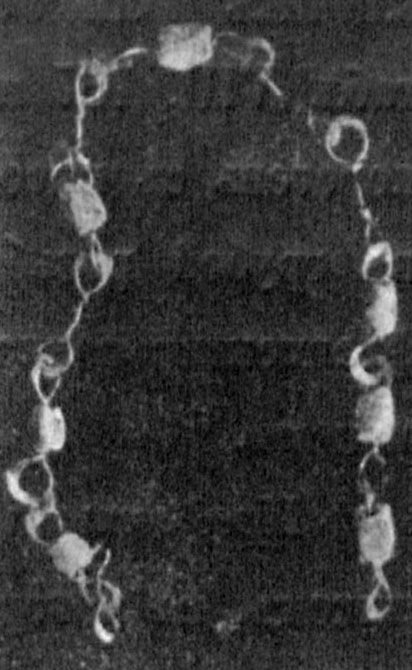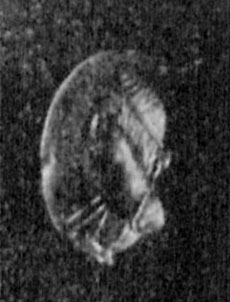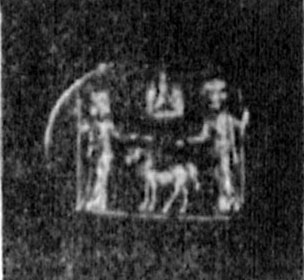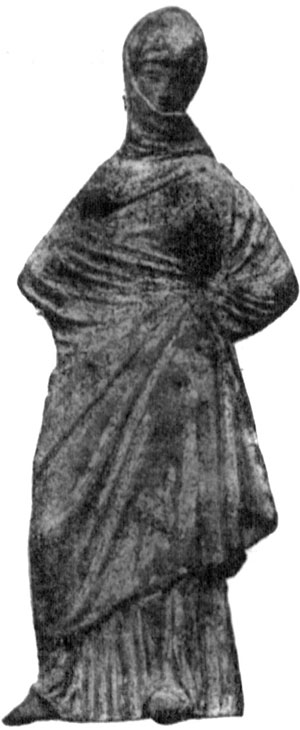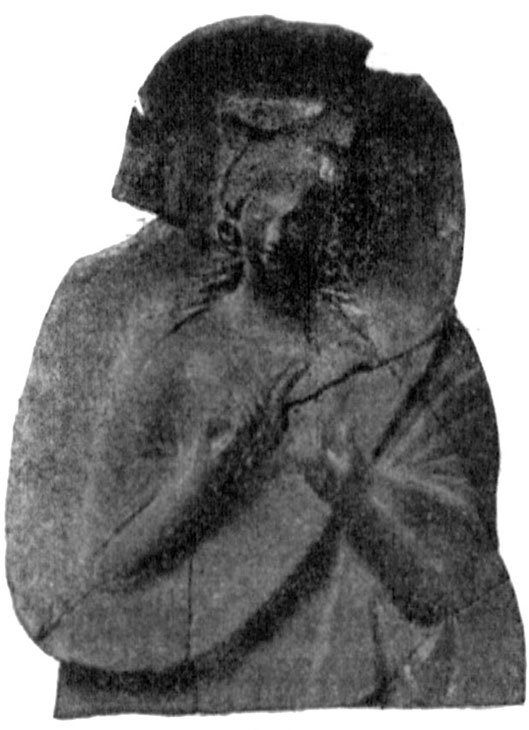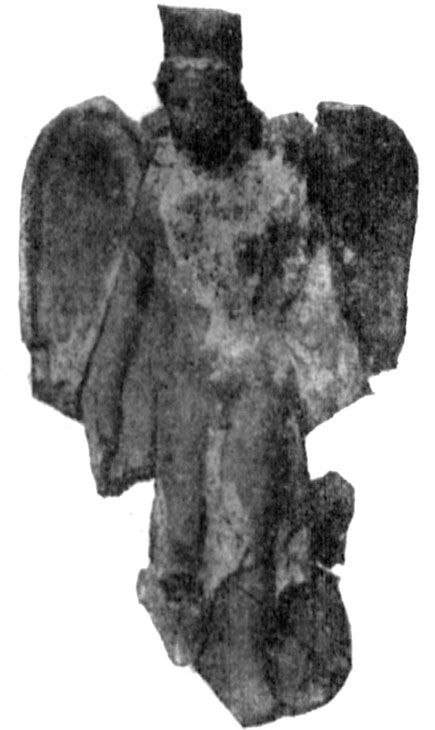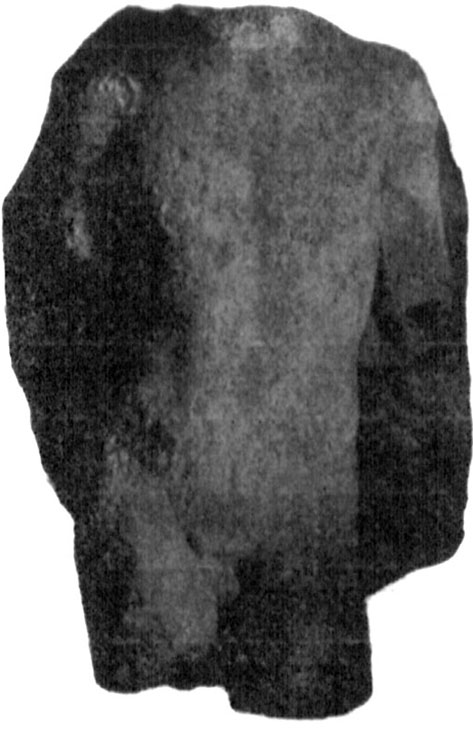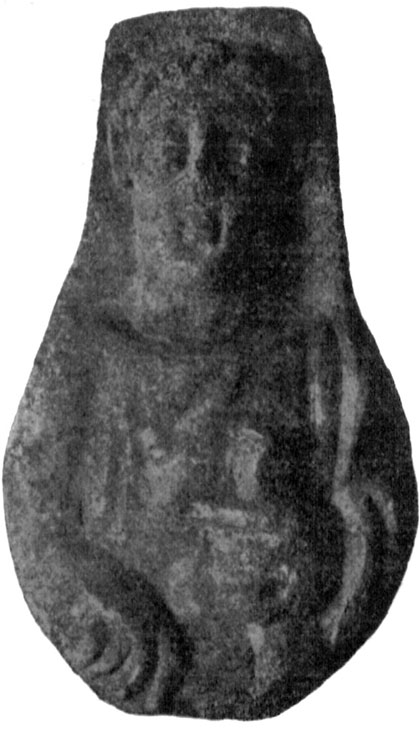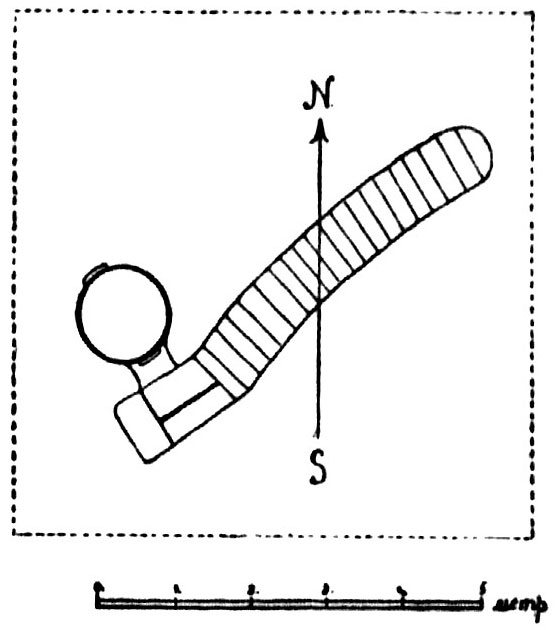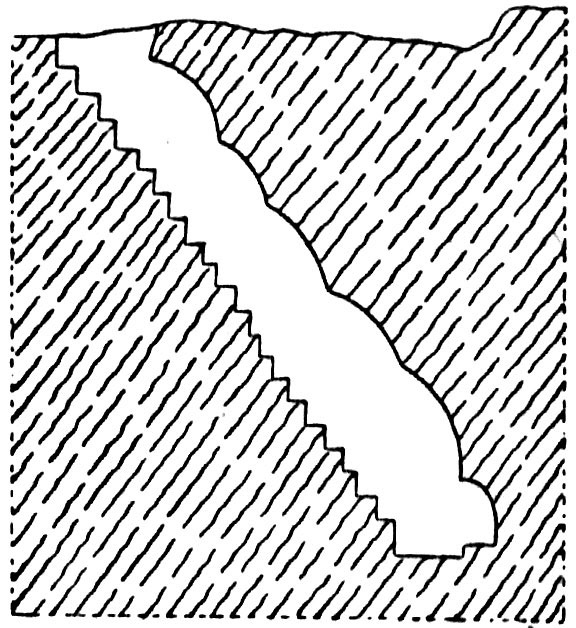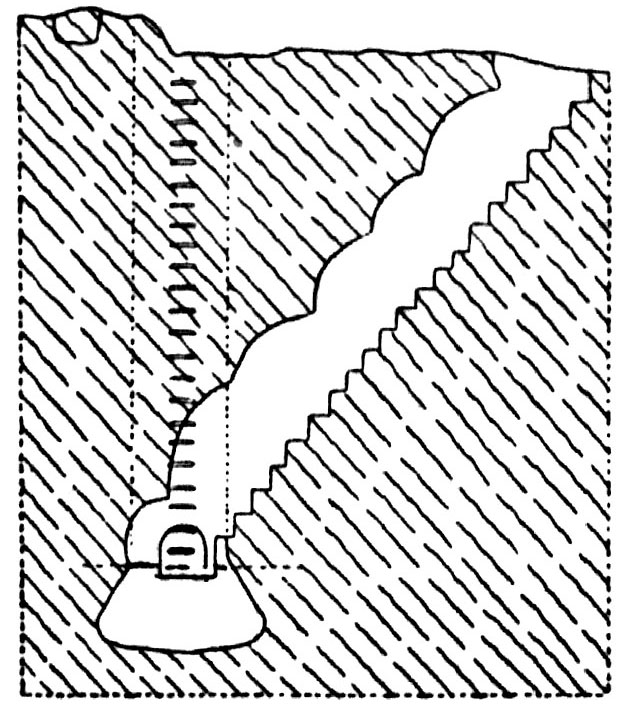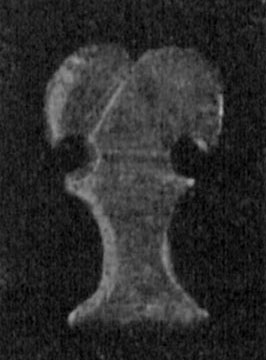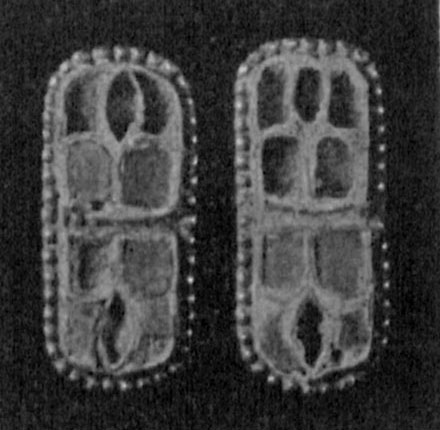 |
 |
 |
|
||
| main :: biography :: texts :: manuscripts :: photographs :: drawings :: squeezes :: publications :: about | ||
|
1905 REPORT OF THE HEAD OF THE EXCAVATIONS IN CHERSONESOS MR K. K. KOSTSYUSHKO-VALYUZHINICH Excavations in Chersonesos
[1]
In Chersonesos, the member of the <Archaeological> Commission K.K.Kostsyushko-Valyuzhinich has investigated in the year under report:
I. The excavations in the first of the areas mentioned above have revealed two streets (7,40 m wide), which probably belonged to the main thoroughfares of the city: the longitudinal street went from the north-east to the south-west, and the transverse street went perpendicularly to it towards the gate in the city wall (ж). One can trace the direction and the limits of both streets from the remained masonries of the Romano-Byzantine period. In the north-east, the longitudinal street has been investigated as long as the place where it crosses another transverse street, which is parallel to the street that finishes at the gate ж. Gate п overlooks longitudinal street; by this gate, it was possible to enter the street from the quarter with house Г [2] . In the latest period of Chersonesos, gate п was blocked with rubblework. A part of this rubblework preserved at the north-east side of the gate. Gate н and wickets о—о led to the quarter and rooms, which were located to the north-west of the longitudinal street. The excavations at the north-west side of the street, approximately in the middle of its part uncovered in the year under report, have revealed tomb и, walls of which are constructed of rubblework, and which dates to the late Byzantine period.
The excavations of the longitudinal street have unearthed remains of drains of three different periods. Slabbed drain д is dates to the Late Byzantine period. Channel е
(Figs. 33а,
33б,
33в)
is laid with cement and cemented from inside, it has egg-shaped profile
[3]
and is located 0,35 m above the bedrock, atop an embankment that dates to the Romano-Byzantine period. The north-east section of channel е runs through desilting well ж. Finally, waterpipe з of ribbed
terracotta slabs
(Fig. 34)
runs atop bedrock, it originates from an earlier period. The excavations at the north-west side of the longitudinal street have unearthed foundations of dwelling rooms of the late Byzantine period (nos. 30-34),
which are simultaneous with drain gutter д. In room no. 34, there were four stones of inner facing of the city wall of the Ancient Greek period (А3) in situ.
As the part of the wall discovered now was perhaps a continuation of its parts (А3—А2) located to the south-east of the longitudinal street, which were unearthed in former times, this year discovery makes clear the direction of the city wall of Greek Chersonesos along a considerable distance The excavations have uncovered rooms nos. 24-29, located from the north-east side of the transverse street, within the wall that faces this side of the street; the wall and the rooms date to the Romano-Byzantine period. Remained walls of these rooms are laid of rough stone with lime. There were channels draining water off rooms no. 26-29 to the main drain of the Romano-Byzantine period г—г, which ran along the transverse street. There was a branch channel to this drain from building Г. Altarless chapel a fronted the transverse street, which north-east section was investigated in 1903 [4] . The excavations of the year under report have uncovered narthex к of the altarless chapel, where five tombs with bones of buried persons were located.
The excavations in the area to the south-west of the transverse street have found rooms no. 1-23. Although most of them date to the Early Byzantine period, there were Late Byzantine reconstructions, which became understandable from the walls of some rooms (pl. II shows these reconstructions with special shading). These Late Byzantine reconstructions are distinctively marked with their wretched rubblework of fine stone with mud. In room no. 1, there was cemented grain pit (1.06 m deep), it was rectangular in plan. The excavations in between of rooms nos. 16, 17, 22, 23 and the city wall have uncovered room В with floor of slabs. (Fig. 35) represents this room viewed from the north-east. The room was constructed in the Romano-Byzantine period, partly of the material that belonged to the buildings of more ancient period; a whole course of slabs from the most ancient period appeared to be in included in its floor. Its walls, laid of rubblework with lime, remained to the height of 0.80-1.42 m.
Longitudinal wall of room В is considerably thicker (0,88-1,02 m) than its transverse walls (0,64-0,80 m) and the walls of all other rooms discovered there. Room В is a narrow rectangle in plan (its outer contour
is 6.43 m wide, the excavated part of it is 14.22-14.93 m long). The room was entered by a door from the south-east. The walls of the room were covered with plaster inside. There were recesses 0.31 m deep with square
mouth (0.17 х 0.17 m) arranged in longitudinal walls of the room with floor of slabs, 0.53 m above its floor. These recesses correspond to holes, which were carved into the floor, 15 on each side (0.08 m deep and 0.17 m in
diameter); these holes of either side are connected with a channel (0.06 m wide). In a later period, the room experienced reconstructions. The door, which opened from the south-east, was blocked; the room was divided into
two parts by a thin transverse wall in its south-western part; near the latter, a part of slabbed floor was removed and grain pit and rectangular grain pit м (1.06 m deep) was carved into bedrock in this place. The
excavations in the room with slabbed floor have uncovered tomb б (1.02 m deep) with a great number of bones, which also dates to the later period. Discovered drainage channels, which were made especially for the room with
floor of slabs, date to the Roman-Byzantine period. There was channel (г), carved into bedrock, which came under the slabbed floor of room В from the south-west. Channel (г) was plastered with opus signinum,
it comes out from under the wall of room B near its north-east side and flows into the main drain canal of the transverse street. There also were channels arranged near longitudinal walls within room В. Finally,
the excavations at the outside of the north-west wall of room В have uncovered one more channel, which was plastered with opus signinum and lined with stone slabs. It received a branch going from under the floor of room
В and set off another branch to the west. There were pottery pipes vertically inserted into this channel in different places. We can hardly discover the purpose of room В. At any rate, it was connected with the
building (thermae), which was discovered in 1898
[5]
The excavations near the city wall have discovered remains of a channel plastered with opus signinum; it dates to the Romano-Byzantine period, drained water off the city and went through the city wall at that place.
The excavations to the north-east of this channel have discovered remains of the most ancient drain; it consisted of solid stone gutters, 0.98-1.11 m long, 0.66 m wide, 0.31 m high, diameter of the gutter was 0.22-0.35 m (в).
Detailed list of the finds discovered by the excavations in the area described above is given in Izvestiya <Imperatorskoy Arkheologicheskoy> Komissii [Proceedings of the Imperial Archaeological Commission] 25, p. 134 ff. We should mention such finds as Ancient Greek limestone capital, Byzantine marble capital with relief cross, fragment of limestone cornice
(Fig. 36)
, limestone drain of sima in the form of like lion’s head, various marble architectural fragments, fragments of marble statues, limestone grave stele
(Fig. 37)
, fragment of marble gravestone shaped like Heracles’ club, copper coins (Chersonesan, Roman, Byzantine, of Pontic colonies), bronze finger-ring with unclear monogram, buckles, badges
(Fig. 38)
, fragment of massive lion’s head with an aperture for ring, fragment of vessel handle with relief head, fragment of arc-handle with monster’s head, fine lock, fragment of fine goat-shaped lock, keys, nails, weigth
(Fig. 39)
, thimble, fragment of handgrip of sword, arrowheads, small closed bells from horse harness, cross
(Fig. 40)
, fragment of reliquary cross, fragments of church chandeliers and candlesticks, lead ring with small aperture, two lead seals, stone spindle whorls, millstone for hand mill, hones, fragment of axe, throwing stones, glassware: fragment of curved stick fragments of bracelets and vessels, round and oval glass insets for medallions and finger-rings (including those with carved images); green glass paste pendant, bone rectangular plate with hole in the middle, hollow chiseled stick with two symmetrical apertures near its top edge, plate for a casket decorated with ornament of circles with points in the middle, pyramid with hole at the top, flat finger-ring, ring with two holes, stick-shaped clasp decorated with circles with dots in the middle, spoon with pointed handle, needle, awl, handle for hanging bell, pendant, different materials (deer’s and wild goat’s horns and wild boar’s tusk), fragments of black slip and simple earthenware pottery, clay lamps (including the ones with Asklepiades’ stamp), fragments of Megarian bowl with stamp
2. The excavations in the Karantinnaya bay started near tower Г, top part of which was uncovered as early as 1899. This year excavations have revealed that tower Г (10.17 m in outer diameter) was flanking tower
during the most ancient Greek period. It corresponds to another flanking tower З. The wall located in between of towers Г and З was the south-east limit of the city during the most ancient period.
The excavations at the outer side of tower Г, which remained to the height of 4.65 m, have been made down to the footing course. There are eight courses survived of the distinctive facing masonry of the Ancient
Greek period (upright ashlars with rustications). Walls of the tower have slight inclination at the bottom, lower than the beginning of the fifth course, though above it the wall goes vertically. Some facing stones keep worker’s
marks in the form of Greek symbols and monograms.The tower was filled with fine stones mortared with clay; in a later period, it was encircled, for strengthening, with rings В, В1, В2 and В3 of rough stones with lime.
Fig. 41
represents this tower viewed from the inside (from the north), after the excavations have removed the latest ring В and have uncovered masonry everywhere near the ancient Greek wall. Ring В was not below the level
of the Byzantine period, though the outer ring В1 reached the bedrock; it was in the same time with postern а, under which there were remains of Ancient Greek postern б. Ring В1 of the stonework
contained a great deal of building materials taken from the Ancient Greek buildings. Ring B2 also reaches bedrock, it forms a supporting pillar; this ring was erected in a period later than ring В1, which face side
it adjoined. Construction of pillar В2 finished the reinforcement of the tower. Ring В3 with stairs Н, which is made of ashlars, was constructed atop a mound to be a platform with stairs leading to the tower,
similarly with the construction of tower Е, which was excavated in 1900. Wall А, which is located between towers Г and З, possesses absolutely the same masonry as the sections of the ancient
Greek wall discovered in 1899 and 1904. In the wall, almost in the middle of it, there was wicket г with platform of stone slabs, under which slabbed drain gutter з was uncovered.
Fig. 42 represents the postern and drain gutter viewed from the south-east. Drain з is connected with Early Roman drain, which was uncovered in 1899 near the Ancient Greek gate; postern г was most probably constructed in the Early Roman period as well. There is a cut for door-locking bar that remained 1.06 m above the doorstep, on the north-east side of the postern. In the Byzantine period, when the ground level was a bit higher, the lower part of postern г was blocked. At the same time, its upper part was widened and covered with vault-shaped roof. Finally, wall д dates to the latest period; it was when wide gate of previous period was destroyed and replaced with this wretched postern.The postern was approached by macadamized road (3.41 m wide). Tower З is of very bad preservation because seawater damaged it a lot. The foundations of wall З were covered with wall А, which was renovated in the Roman period, and another auxiliary wall А3 with its projections and pillars of ashlars. Wall А2 (up to 2.13 m high) branches off the wall А near the tower and goes to the north-west; it is laid of rough stone with lime and faced with slabs, most of which originate from the stonework of the Ancient Greek wall. The excavations have revealed three rectangular holes in wall А2, through which drainage channels went to the bay. The excavations have uncovered remains of buildings and constructions of the Roman and Byzantine periods at the inner, north-west side of the wall, which went in between of towers Г and З (the plan distinguishes them with different shading). Wells и and i and three crushed pithoi, which were uncovered in that place, date to the same periods. Platform near the wells and pithoi is paved with flagstones. Uncovered there buildings (nos. 1 – 7) are remains of dwelling rooms.In the lower layer, there were remains of Ancient Greek structures (pillars в that probably supported awnings; remains of water pipe of terracotta slabs ж). There was a street going from postern г to north-west. It went out of postern г and continued to the south-west. Excavations uncovered there sites of the Roman and Byzantine periods (nos. 8 – 15). There have been revealed two limestone statue bases of Corinthian order in room no. 9 and a big pear-shaped in section pithos in the beginning of the side-street.
The excavations in this section of the ancient city have unearthed numerous ancient artifacts
[6]
Among others, we should note various marble architectural members, fragmens of mosaic floor from some building, inscriptions and their fragments
[7]
, fragmented marble herma, fragmented marble statue of lying lion with the head turned aside
(Fig. 43)
, fragments of marble and stone vessels, copper coins
[8]
, various bronze utensils and decorations, namely: link of chain for icon lamp, key, fishhooks, needles, fly-shaped brooch
[9]
, finger-ring with hexagonal flat panel decorated with unclear carving, charming cylinder, pendant in the form of human figure, badge decorated with rosettes; buttons, clasp in the form of narrow bronze plate which is circular in the middle and decorated with openwork cross
(Fig. 44)
, solid ring with oval projection from one side where bird was carved and two bars on the other side, which supported curved bitted key hanged to them; crosses of various shapes and size;
one of them (Fig. 45) has an inscription
3. The excavations in the area between the casemate for fortress artillery and the warehouse of antiquities, on the shore of the bay, have finished the investigation of the south-east extremity of the ancient city. The excavations have reached bedrock or seawater horizon everywhere. The excavations have uncovered a small remain of the sea wall of the city (А4), which dates to the Ancient Greek period, it was located to the left of the former sentry box, in the lower layer [11] . This wall is laid of rough stone with clay and was lined with ashlars from the outer side and with dressed stone from the inner side. In the Byzantine period, this Ancient Greek wall was dismantled, so that the stones from it were used for building wall А2, which dated to the Byzantine period. Only those parts of the Ancient Greek wall have survived (they are up to 1.84 m high) that laid below the level of the Byzantine period, when a street was constructed atop the remains of the ancient wall. The continuation of the Ancient Greek city wall has been discovered to the south-east of its part already described, near с1—с2; the part of the wall uncovered there (two lower courses of its masonry survived) is, however, located along another axis than the part at the sentry box. Further eastwards from point с2, the wall of the Ancient Greek period made a turn and formed a curve similar to those at the towers [12] . Two lower courses of typical Ancient Greek masonry with cuts for binding remained near the curve. As it can be seen from the plan, the direction of city wall А2 of the Byzantine period coincides with that of Ancient Greek wall only in parts; Byzantine walls sometimes reaches the height of 3.63 m. In the Byzantine period, the curve of the ancient Greek wall was strengthened with bulge а—а, outer side of which was faceted. Wall д, which adjoins the ancient wall, was laid of rough stone with lime in the Byzantine period. Drainage channel в, which runs through the city wall to the south-east of wall д, dates to the Byzantine period. The layer below drain в appeared to include slabbed platform г, which possibly was the foundation of the Ancient Greek city wall that continued this direction. The excavations have uncovered the remains of the Byzantine coastal wall, which are scattered everywhere to the north-east of the faceted corner curve, as far as the sea. These remains are masonry of big dressed stones with cuts for binding. In this area, coastal wall is partly destroyed by the sea waves, which caused caollapse of the shore. This way, big rectangular tower К of the Byzantine period, which is located there, is half-destroyed. In this area, Ancient Greek wall was probably dismantled completely in the Early Byzantine period, during the construction of wall A2 and tower К. In the period after wall д was constructed, rectangular grain pit б, 2.13 m deep, was built to the north-east of it. The walls of the pit are lined with rubblework and plastered with fine-grained opus signinum, though the floor is paved with rectangular bricks (0.72 х 0.59 х 0.045 m). The excavations have uncovered remains of the city walls of different periods, as well as remains of houses of three different periods, which are shown with different shading on the plan [13] Remains of shed with pillars е—е ( Fig. 47 ; viewed from the east) and rooms I – VIII date to the Ancient Greek period. In room II, we should mention pottery kiln з, a pit in bedrock и (it could be used for preparation of clay), and arch-shaped niche carved into bedrock (i). The excavation of room VII has revealed vaulted kiln н, stone stairs, small corridor and small chamber, which could be a storeroom. Room VIII overlooked the street; direction of the latter in the ancient Greek period probably corresponded with the Byzantine period. Room VIII is related to four cylindrical wells, which have been uncovered in this area, lined with stone (о—о), and four egg-shaped grooved pithoi (п—п), which were uncovered broken into pieces. The excavation has uncovered another nine crushed pithoi, which were pear-shaped in cross-section (р—р), in the same place, in the upper layer. These pithoi contained remains of salt fish. Pithoi р—р are related with the Early Byzantine house, which was constructed at the place where the Ancient Greek house VIII had been located.
Rooms nos. 1 – 5 date to the Early Byzantine period. There were three cuts in bedrock for pithoi (л—л) and cylindrical well м in room no. 3. The excavation in room no. 2 has uncovered well К; pear-shaped in cross-section (2.13 m deep), it was carved into bedrock and cemented. Its top part was lined with stone slabs. Drainage channel ж—ж dates to the Early Byzantine period; constructed above a mound, it is laid of stone mortared with lime and was cemented inside. This channel runs through the Byzantine city wall. There is paved platform arranged on both sides of it. Among the ancient artifacts discovered by the investigation of the south-east extremity of the ancient city, there were interesting marble architectural fragments, fragment of marble statue of lying boy (Fig. 48) , marble torso (preserved height 0.19 m), fragment of foot of marble life-size statue of lion, pieces of wall-plaster painted red and light-blue color, stone millstone of hand-mill, hones, throwing stones, sinkers of red slate, clay pyramidal sinkers with marks, cylindrical sinkers, clay spindle whorls, clay lamps of various forms and different trim, stamped amphora handles, fragments of stamped roof tiles, shards of black-slip, red-slip, and plain earthenware pottery (including artifacts with graffiti and stamps), shard of a vessel with handle decorated with reliefs (thursus and bands on top and maenad’s head aside), various coins, shards of glass pottery, fragments of glass bracelets of various colors and forms, shards of thick glasses, wild boar’s tusks, fragment of magic obsidian gemstone. 4. For the plan of the area of necropolis of Chersonesos, which has been investigated in the year under report near Karantinnaya bay, where the modern monastery stockyard is located, see pl. V. The excavations have discovered a site of quarry of the Roman period, which was located in this part of the necropolis, on the north-west (bedrock was cut along the direct line from grave no. 2082 to the lime-shed). In this area, the excavations have uncovered very big number of graves, namely 457, located within relatively small area. There were 121 graves in the form of carved into bedrock well, 41 family vaults carved into bedrock, 1 rectangular hollow in bedrock with fired bones, 12 cists laid of roof tiles, 4 cists composed of slabs, 1 cist laid of stone, 1 stone sarcophagus, 22 clay urns with fired bones and skeletons of babies, and 256 well-shaped pits in the upper layer of soil, above bedrock. All the types of graves mentioned above are known from the excavations in previous years. Well-shaped graves, which were carved into bedrock, were sometimes covered with dressed stone slabs (no. 1945). Urns with fired bones were of various forms. Urns were either put directly to the soil, or there was a pit, carved into bedrock to receive the urn (no. 1968), or there was a cist constructed of slabs (no. 1964) or tiles (no. 1942), also for the urn. Tomb no. 1944 is a shallow (0.53 m) pit in bedrock with its top part composed of roof tiles; the tomb was also covered with tiles from above. Grave no. 1983 was dug into soil and faced with roof tiles. This year’s excavations have investigated vaults, the forms of which are in every respect well-known in Chersonesos. Vault no. 1663 should be considered the biggest of all uncovered to the moment (6,84 х 8,28 х 1,95 m). Some vaults have wall-plaster. The passages to the constructions do not reveal any new feature, all the same as stone barriers of graves and organization of places for burials. Some vaults have rounded corners at the ceiling. In big vaults, there are parts of bedrock, which were not cut off but left in the form of support pillars in order to prevent ceiling from falling down; one of such pillars (in vault no. 2078) is square in cross-section, with base and capital in the form of truncated pyramid with wider side up. Many graves were plundered. In most cases, the plunder was the same as fixed in previous years of excavations. Ancient graves were often destroyed by construction of later graves in the same place. Besides that, ancient vaults were used for burying in a later period, more ancient remains were destroyed and plundered. I most cases, orientation of the dead and their position were usual. The excavations have uncovered additional burials made into already existed graves. Some vaults contained great number of skeletons. Perhaps, these vaults were in use for very long time. The excavation of grave no. 1945 has unearthed two skeletons laying without wooden coffins. On the floor of vault no. 2055, there were nine rotten coffins with gable covers; there was one copper coin laying on top of each coffin cover, above the head; three coffins contained copper coins accompanying the skeletons. It was a rite to bury children in clay amphorae (grave no. 1678). We should note that graves nos. 1652, 1658, 1891 and 1942 contained skeletons in unusual positions [14] Two graves contained skeletons with deformed skulls (nos. 1653 and 1673). Grave no. 1650 contained skeleton of a horse. All the artifacts, which have found by the excavations of the necropolis, are usual and belong to the same categories as the artifacts discovered in the previous years of excavations. There is a detailed list and description of the artifacts in K.K.Kostsyushko-Valyuzhinich’s in Izvestiya Imp<eratorskoy>Arkheolo<gicheskoy>Komissii [Proceedings of the Imperial Archaeological Commission], volume 25. The uncovered artifacts supply evidence that the necropolis area within the limits of modern monastery stockyard contains the graves dating from the foundation of the city to the period of the Russian annexation of the Crimea.
It is interesting to note that the excavations have uncovered the following ancient artifacts.
Golden artifacts. Medallion
(Fig. 49)
framed with openwork eggs, with inserted copper coin of Caracalla, plated with gold sheet.
— Necklace (Fig. 53) in the form of wire chain, which terminates in hook and consists of ten links, four of which keeps elongated lignite pierced beads; two oval medallions are put on the chain, the bigger medallion is decorated with carved carnelian depicting shepherd and goat, the smaller with octahedral amethyst. — Fragment of a necklace (Fig. 54) of thinnest wire and glass 14-hedral pierced beads. — Openwork buckle, which was carved of a thick plate (Fig. 55) . — Simple finger-rings, wire earrings, impressions of coins, oval sheets for covering mouth, sewing badges for clothes (in the form of shells and hemispheres), charming tubes, leaves of wreathes, piece of leaf gold.
Silver artifacts. Medallion with oval carved agate depicting young man in front of herma.
Carved gems. Dark-brown jasper with image of woman’s head, to the left
(Fig. 56)
.
Bronze artifacts. Earring with bludgeon-shaped pendant, earring with pendant in the form of pyramid of balls, ring-shaped pendants, toothed medallion, charming tubes, buckles, snake-shaped bracelet, ring-shaped bracelets, conical bell with eyelet, rings of hoarse harness and horse bits, straight key with ring, ring-shaped key, brooches (of the type Almgren, plate VIII, 187 and 190), arrowheads, vessel with arched handle, finger-ring with high plate shaped like a cone with base up, where horse figure is depicted by rough carving, seal of the year 1788 with letters
Iron artifacts. Finger-rings (including artifact with carved carnelian depicting ant), big buckle, knives, fire lighter, fragments of athlete’s scraper, fragment of door key.
Clay ware and terracotta ware. Statuette of woman wearing himation, of excellent workmanship (Fig. 58) [15] two hollow half-figures of Cora (Fig. 59) with traces of painting [16] fragmented statuette of Eros (Fig. 60) , statuette of young man sitting with hare and dog, fragmented statuette of dancing woman, statuette of pigeon resting on round pedestal.
Pottery. Black-slip vessels of various forms (with graffiti on some of them); among them, there is an interesting single-handled cup with inscription encircling it: Glass artifacts. Finger-ring of the same form as gold artifact, decorated with carved image of sitting Athena, which was unearthed in 1899 in vault no. 1012. — Black finger-ring with plain panel, crescent-shaped pendant, two checkers (black and green) in the form of circles, segment-shaped in vertical section, and various pottery. Bone ware. Pedestal, 0.035 m high, octahedral, with double cornices on top and bottom, square in cross-section, with four legs; there is vertical reach-through hole. — Oval plate decorated with three double circles with dot in the middle; there are two holes drilled at either side of the central decoration. — Plate, twice wrapped with silver wire, with an eyelet. — Handle with hole, for toy bell. — Awl, handles of knives, and wild boar’s tusks.
Wooden artifacts. Fragment of comb decorated with carved openwork image of bust of human figure in medallion; fragment of comb with long teeth, simple comb, fragments of spindle with wooden whorl put on it, part of casket made of solid piece of wood with sliding wooden cover (fine bronze internal lock, which was uncovered nearby, could be a part of this casket).
There also were other finds: inscriptions [18] , limestone gravestone in the form of human bust of rough workmanship, various pierced beads (for necklaces, bracelets, bridle decorations) and pendants (four coral pendants in the form of amphora from grave no. 1955 attract special attention), ten lead trefoils with hooks at places of stems (from grave no. 1947), clay playing balls, remnants of wooden footwear and brown textile. The excavations of the mound of necropolis have uncovered fragments of grave monuments including marble fragment of heroized dead person, fragment of marble stele with relief image of young man’s torso (Fig. 61) , fragment of another stele depicting left foot wearing sandal, fragment of marble gravestone depicting man (Fig. 62) , fragments of burial and other inscriptions [19] , architectural fragments of limestone, flints scraper, fragment of stone hammer with blunt end, hones, bronze keys, pendants for horse harness, needle, bracelets, finger-ring with oval panel decorated with carved image of Eros, belt buckle, three rings of different size (possibly for a belt), coins, iron finger-rings and buckles, shards of roof tiles (including stamped artifacts), stamped amphora handles, shards of black-slip and simple clay pottery and lamps, shards of glass pottery, glass pendants, bone artifacts: comb, fine spoon, button and fragments of box.
5. There were 44 various graves located to the south of the Greek-cross plan church. Their types and details of construction are the same as that in the necropolis at place of present stockyard. Two vaults (no. 2086 and 2114) contained remains of fresco paintings
[20]
. The excavations near graves no. 2100 and 2101 have discovered a well with sloping gallery leading to it, which was carved in bedrock
(Figs. 63а, 63б,
63в)
.
The finds from the graves and from the necropolis mound mostly belong to well-known types. New forms appeared but rare. This way, the finds include two bronze buckles of the form that never appeared in Chersonesos before
(Fig. 64)
. Further, we should mention two plates of the worst kind of silver
(Fig. 65)
, which are decorated with color enamel inserted into gold framework, two specimens of unpublished variant of copper coin of Chersonesos of the time of eleutheria (attacking Artemis – head of Apollo in wreath, to the left, not to the right as on the specimens which were known before). Amidst the finds from the mound, we should call your attention to fragments of inscriptions
[21]
.
|
||||||||||||||||||||||||||||||||||||||||||||||||||||||||||||||||||||||||||||||||
| ©National Preserve of Tauric Chersonesos . 2007 - 2025 |
